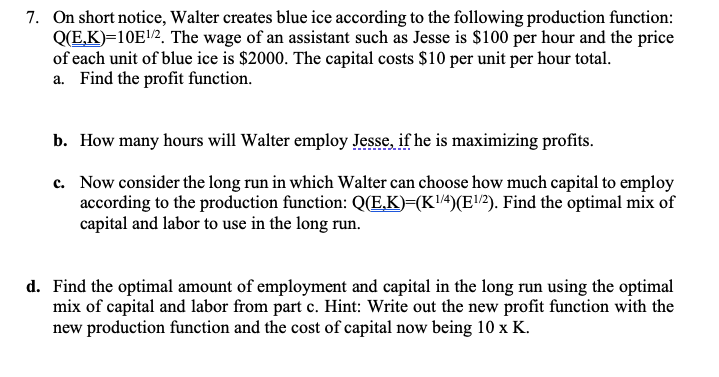of each unit of blue ice is $2000. The capital costs $10 per unit per hour total a. Find the profit function. b. How many hours will Walter employ Jesse, if he is maximizing profits. c. Now consider the long run in which Walter can choose how much capital i according to the production function: Q(E,K)=(K4)(E!2). Find the optim capital and labor to use in the long run. Find the optimal amount of employment and capital in the long run using th mix of capital and labor from part c. Hint: Write out the new profit function
of each unit of blue ice is $2000. The capital costs $10 per unit per hour total a. Find the profit function. b. How many hours will Walter employ Jesse, if he is maximizing profits. c. Now consider the long run in which Walter can choose how much capital i according to the production function: Q(E,K)=(K4)(E!2). Find the optim capital and labor to use in the long run. Find the optimal amount of employment and capital in the long run using th mix of capital and labor from part c. Hint: Write out the new profit function
Microeconomics: Private and Public Choice (MindTap Course List)
16th Edition
ISBN:9781305506893
Author:James D. Gwartney, Richard L. Stroup, Russell S. Sobel, David A. Macpherson
Publisher:James D. Gwartney, Richard L. Stroup, Russell S. Sobel, David A. Macpherson
Chapter12: The Supply Of And Demand For Productive Resources
Section: Chapter Questions
Problem 13CQ
Related questions
Question
c and d

Transcribed Image Text:7. On short notice, Walter creates blue ice according to the following production function:
Q(E,K)=10E/2. The wage of an assistant such as Jesse is $100 per hour and the price
of each unit of blue ice is $2000. The capital costs $10 per unit per hour total.
a. Find the profit function.
b. How many hours will Walter employ Jesse, if he is maximizing profits.
c. Now consider the long run in which Walter can choose how much capital to employ
according to the production function: QE,K)=(K4)(E!?). Find the optimal mix of
capital and labor to use in the long run.
d. Find the optimal amount of employment and capital in the long run using the optimal
mix of capital and labor from part c. Hint: Write out the new profit function with the
new production function and the cost of capital now being 10 x K.
Expert Solution
This question has been solved!
Explore an expertly crafted, step-by-step solution for a thorough understanding of key concepts.
Step by step
Solved in 2 steps with 2 images

Knowledge Booster
Learn more about
Need a deep-dive on the concept behind this application? Look no further. Learn more about this topic, economics and related others by exploring similar questions and additional content below.Recommended textbooks for you

Microeconomics: Private and Public Choice (MindTa…
Economics
ISBN:
9781305506893
Author:
James D. Gwartney, Richard L. Stroup, Russell S. Sobel, David A. Macpherson
Publisher:
Cengage Learning

Economics: Private and Public Choice (MindTap Cou…
Economics
ISBN:
9781305506725
Author:
James D. Gwartney, Richard L. Stroup, Russell S. Sobel, David A. Macpherson
Publisher:
Cengage Learning


Microeconomics: Private and Public Choice (MindTa…
Economics
ISBN:
9781305506893
Author:
James D. Gwartney, Richard L. Stroup, Russell S. Sobel, David A. Macpherson
Publisher:
Cengage Learning

Economics: Private and Public Choice (MindTap Cou…
Economics
ISBN:
9781305506725
Author:
James D. Gwartney, Richard L. Stroup, Russell S. Sobel, David A. Macpherson
Publisher:
Cengage Learning


Principles of Microeconomics (MindTap Course List)
Economics
ISBN:
9781305971493
Author:
N. Gregory Mankiw
Publisher:
Cengage Learning

Principles of Microeconomics
Economics
ISBN:
9781305156050
Author:
N. Gregory Mankiw
Publisher:
Cengage Learning
